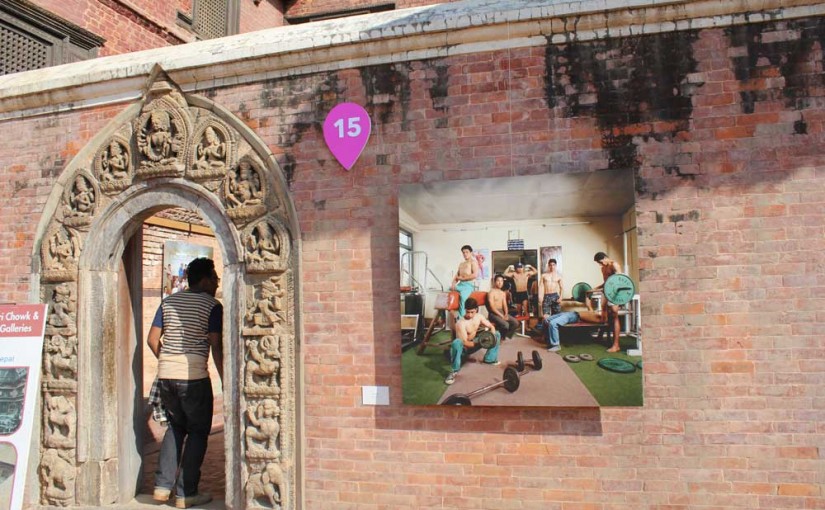After 20 years, Finish photographer Tuomo Manninen is back in Nepal for the Photo Kathmandu Festival. “Me/We”, a part of his long term series on group portraits, brings visitors back to the origins of this project, the Kathmandu of the 90s.
Upon his first arrival in 1995, Tuomo was confronted with a monotone representation of Nepal in photographs that didn’t match the deep socio-cultural and political changes the country was facing. He felt the need to find a new visual language in order to express what he was seeing and experiencing around the city. In the group portraits, which started from a Lazimpat fitness center, he found the form of expression he was looking for.
There were two kinds of images coming from Kathmandu – either the smiling villagers with the mountain backdrop or the NGO material about sickness and poverty. And all of a sudden I was in the middle of a rising, pulsating Asian city, with rock bands, stock exchange, scouts and wedding bands. I just started to document them. And this is what I have been doing for the past 20 years.
The group, in contrast to the mass, is composed of people sharing the same aim, destiny, or method. In his photographs, the groups are held together by common activities, each represented through a set of accessories; the uniform in his portrait of the Pashupati School Scouts, the cricket bats in his capture of the Gairidhara Cricket Club or the instruments of The Newars. Although the photographer admits to hardly spending time on the objects, and rather sees them as elements for posing – something to lean or sit on – they become an index of the group. They point to its existence, activities and identity. This physical reality is contrasted by the staged composition of the figures. In addition to the extensive use of artificial light, their choreographed positioning gives the portraits a synthetic character. While the props suggest movement, prior or following to the shot, it is rarely caught on camera.
Somebody once said that these are photographs of architecture with some people thrown in in. And this, I pretty much subscribe. First, I set the camera, I select the background, and after that I start thinking about the people. I still shoot on film, so before starting to shoot, I shoot a Polaroid, just to see that everything is working. And I try to show that Polaroid to everybody who is posing, discussing their pose with them.
Tuomo’s photographs however, often have unexpected details – small contingencies – that break with the rigidness of the figures’ posture; be it the black socks and shoes of a girl scout, something red lingering on a white floor next to Miss Nepal, or the lettering ‘Perfect People’ on top of a motorcycle repair shop. It is these comical escapes that catch the eye of the attentive beholder and make worthwhile a second visit to the Mulchowk entrance of Patan Museum, where the exhibition is on display until Monday, 9th November 2015.
By Marlene Harles
We: Tuomo Manninen
What comes across most strongly in the group portraits that comprise Finnish photographer Tuomo Manninen’s We series—presently on display at the Mulchowk entrance of the Patan Museum complex—is a sense of pride. Every piece features a different collective, whether it be that of municipal sweepers or musicians or school scouts or mechanics. And in each, most subjects are found staring directly into the camera, at us, with a definite—and in some cases almost defiant—confidence in who they are and what they do.
The 14 photographs on exhibit were part of a larger collection put together by Manninen during a visit to the country between 1995 and 1996, but aside from a few obvious “period” prompts—such as the shot of workers of Mercantile Computers surrounded by their clunky gear—we don’t see much confining the images to any isolated era. There’s the gang of burly body-builders, draped across a barbell-littered gym in Lazimpat, flexing, lifting, preening; the New Bhadrakali Wedding Band outfitted in full finery, shiny instruments in hand; the staff of the Jawalakhel Zoo lined up in front of one of their animals; and the quintet of lorry drivers hanging off of a brightly-painted truck, among others. In this way, Manninen has insisted on seizing the specific environments in which these collectives function, not only in terms of place, but also in featuring the tools of their trade, the equipment, costumes and other markers of the particular worlds they inhabit.
But while the photographs do seek, on the one hand, to depict the reality of the subjects’ domains, on the other, there is a marked staginess about the manner in which the people themselves are presented here. Figures have been generally positioned right smack in the centre of the frame, chins held high, expressions somber, postures rigid and practically heroic in places, all contributing to what feels like a distinctive tribute to the dignity of labor. Manninen has made it so that we can’t help but meet their gazes, sparking an instant connection to each individual, and by extension to the group; it’s a reminder of the prestige inherent in work, and of the need to value all contributions, whatever shape or form these might take. This layering of the real and the contrived attributes an appealing, whimsical quality to the collection.
Text by Preena Shrestha

